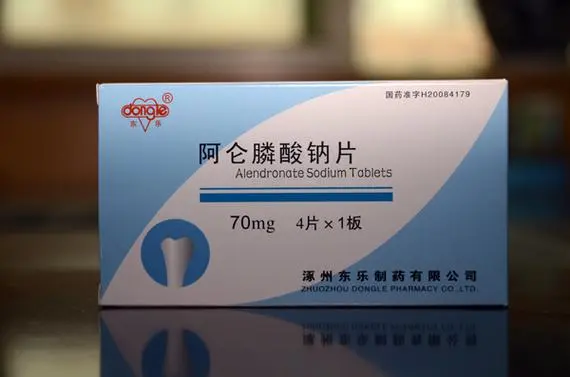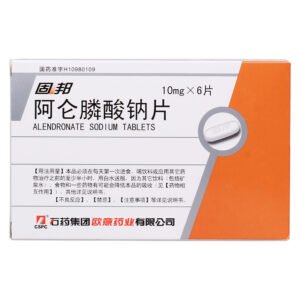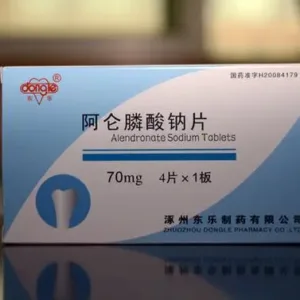ALENDRONATE SODIUM TABLETS.
Functions and indications:
Used to treat osteoporosis in postmenopausal women to prevent hip and spine fractures (vertebral compression fractures). 2. Suitable for the treatment of male osteoporosis to increase bone mass. 3. The 10mg specification of this product is suitable for the treatment of osteoporosis caused by glucocorticoids in postmenopausal women. These patients have used glucocorticoids at a dose equivalent to 7.5mg or more of prednisone per day, and have already developed low bone density. Patients must supplement with an appropriate amount of calcium and vitamin D while receiving glucocorticoid treatment.
Usage and Dosage:
This product has a variety of dosage forms and specifications. The same drug produced by different manufacturers may have inconsistent instructions. Please read the drug instructions carefully before taking the drug and follow the doctor’s instructions. 1. This product must be taken at least half an hour before the first meal, drink or other drug treatment every day. Take it with plain water, because other drinks (including mineral water), food and some drugs may reduce the absorption of this product. (See [Drug Interactions]) 2. This product is an enteric-coated tablet, which may theoretically reduce adverse reactions in the esophagus, but to ensure safety. The following medication method is recommended: In order to deliver the drug to the stomach as quickly as possible and reduce irritation to the esophagus, this product should be taken with a full glass of water in the early morning, and the patient should avoid lying down at least 30 minutes after taking the drug and before the first meal of the day. This product should not be taken at bedtime or before getting up early in the morning, otherwise it will increase the risk of esophageal adverse reactions (see [Precautions]). If the intake from food is insufficient, all osteoporosis patients should supplement calcium and vitamin D (see [Precautions]). 3. Elderly patients or patients with mild to moderate renal insufficiency (creatinine clearance 35-60ml/min) do not need to adjust the dose. Due to the lack of relevant medication experience, this product is not recommended for patients with more severe renal insufficiency (creatinine clearance 5ml/min). 4. Treatment of osteoporosis in postmenopausal women: The recommended dose is: once a week, 1 tablet of 70mg; or once a day, 1 tablet of 10mg. 5. Treatment of male osteoporosis to increase bone mass: The recommended dose is: 1 tablet of 10 mg once a day. As an option, 1 tablet of 70 mg once a week can also be considered. 6. Treatment of glucocorticoid-induced osteoporosis in postmenopausal women who have not used estrogen: The recommended dose is: 1 tablet of 10 mg once a day.
Adverse reactions:
According to foreign literature reports: 1. Clinical studies: In clinical studies, alendronate sodium is generally well tolerated. In some studies lasting up to 5 years, adverse reactions are usually mild and generally do not require discontinuation of drug treatment. Treatment of osteoporosis in postmenopausal women: In two large, virtually identically designed, three-year, placebo-controlled, double-blind, multicenter studies, 10 mg of alendronate sodium was used daily, and the results showed that its overall safety profile was similar to that of the placebo group. Upper gastrointestinal adverse reactions reported by researchers in ≥1% of patients receiving 10 mg of alendronate sodium daily that were possibly, probably, or definitely drug-related and occurred at a higher rate than placebo included: abdominal pain, dyspepsia, esophageal ulcer, dysphagia, and abdominal distension. Rash and erythema rarely occurred. In addition, adverse reactions reported by researchers in ≥1% of patients receiving 10 mg of alendronate sodium daily that were possibly, probably, or definitely drug-related and occurred at a higher rate than placebo included: musculoskeletal pain, constipation, diarrhea, flatulence, and headache. 2. Treatment of osteoporosis in men: In a two-year double-blind, placebo-controlled, multicenter clinical study, the safety profile of 146 male patients taking 10 mg of alendronate sodium daily was consistent with that of postmenopausal women. 3. Post-marketing experience: (1) Systemic reactions: Allergic reactions include urticaria and rare angioedema. As with other bisphosphonates, transient acute phase reactions (myalgia, malaise, and rarely fever) may occur when starting alendronate. Hypocalcemia may occur rarely in the presence of predisposing conditions. (2) Gastrointestinal reactions: nausea, vomiting, esophagitis, esophageal erosions, esophageal ulcers, rarely esophageal stricture or perforation, oropharyngeal ulcers, and rarely gastric and duodenal ulcers. Some are more serious and are associated with complications, although a causal relationship with the drug has not been established. Osteonecrosis of the mandible may occur rarely in the setting of delayed healing of tooth extractions and/or local infections. (3) Musculoskeletal: Bone, joint, and/or muscle pain, rarely severe and/or disabling conditions. (4) Skin: rash, pruritus. Rare severe skin reactions, including Stevens-Johnson syndrome and toxic epidermal necrolysis. (5) Special senses: Rarely, uveal hypopigmentation, rarely, iritis or inflammation of the outer layer of the iris. 4. Laboratory results: In a double-blind, multicenter, placebo-controlled clinical study, 18% and 10% of patients in the alendronate group experienced asymptomatic, mild, and transient decreases in serum calcium and serum phosphorus, respectively, and 12% and 3% in the placebo group, respectively. However, the incidence of serum calcium <8.0mg/dl (2.0mmol/L) and serum phosphorus <2.0mg/dL (0.65mmol/L) was similar in the two groups.
Contraindications:
1. Esophageal abnormalities that cause delayed esophageal emptying, such as esophageal stenosis or achalasia. 2. Those who cannot stand or sit upright for at least 30 minutes. 3. Those who are allergic to any component of this product. 4. Hypocalcemia ([Precautions]).
Share:
Products
Our offers
Health Classification
Let us work together to protect precious health






























